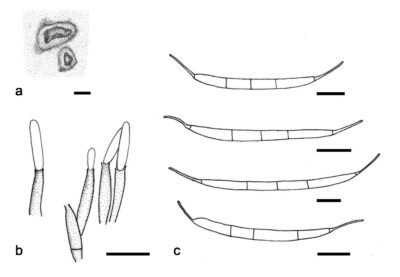Fungalpedia – Note 295, Calvolachnella
Calvolachnella Marinc., T.A. Duong & M.J. Wingf
Citation when using this entry: Perera et al. 2024 (in prep) – Fungalpedia, genera described in 2016.
Index Fungorum, Facesoffungi, MycoBank, GenBank, Fig. 1
Classification: Incertae sedis, Chaetosphaeriales, Sordariomycetidae, Sordariomycetes, Pezizomycotina, Ascomycota, Fungi
Hernandez-Restrepo et al. (2016) established the monotypic genus Calvolachnella to accommodate asexual taxon C. guaviyunis found on the bark of Myrcianthes pungens. In the phylogenetic analysis of combined ITS and LSU sequence data P. guaviyuensis formed an independent lineage apart from other genera in Chaetosphaeriales. However, the genus has not been assigned to a family and left in Chaetosphaeriales, Incertae sedis (Hernandez-Restrepo et al. 2016). Calvolachnella is characterized by scattered, acervular, cupulate conidiomata with a broadly attached base to the substrate without setae. Conidiophores are arising from the concavity of the conidiomata, pale brown, septate and branched at the base. Conidiogenous cells are subhyaline to pale brown, phialidic and cylindrical. Conidia have setulae at both ends and are fusiform, hyaline to pale brown and straight to slightly curved. (Hernandez-Restrepo et al. 2016). The sexual morph is undetermined. Calvolachnella differs from other related genera in that its conidiomata lack setae, pale brown to brown conidiogenous cells and, hyaline to pale brown conidia (Hernandez-Restrepo et al. 2016).
Type species: Calvolachnella guaviyunis (Marinc., T.A. Duong, M.J. Wingf. & C.A. Perez) Marinc., T.A. Duong, M.J. Wingf. [as ‘guaviyuensis‘]
Other accepted species: This genus is monotypic.
Figure 1 – Calvolachnella guaviyunis (CBS 134695, ex-type). a Cupulate conidiomata. b Conidiogenous cells. Conidia with cellular appendage at both ends. Scale bars: a = 250 μm, b, c = 10 μm. Redrawn from Hernandez-Restrepo et al. (2016).
References
Entry by
Rekhani Hansika Perera, Center of Excellence in Fungal Research, Mae Fah Luang University, Chiang Rai, 57100, Thailand.
(Edited by Kevin D. Hyde, Samaneh Chaharmiri-Dokhaharani, & Achala R. Rathnayaka)
Published online 8 July 2024
